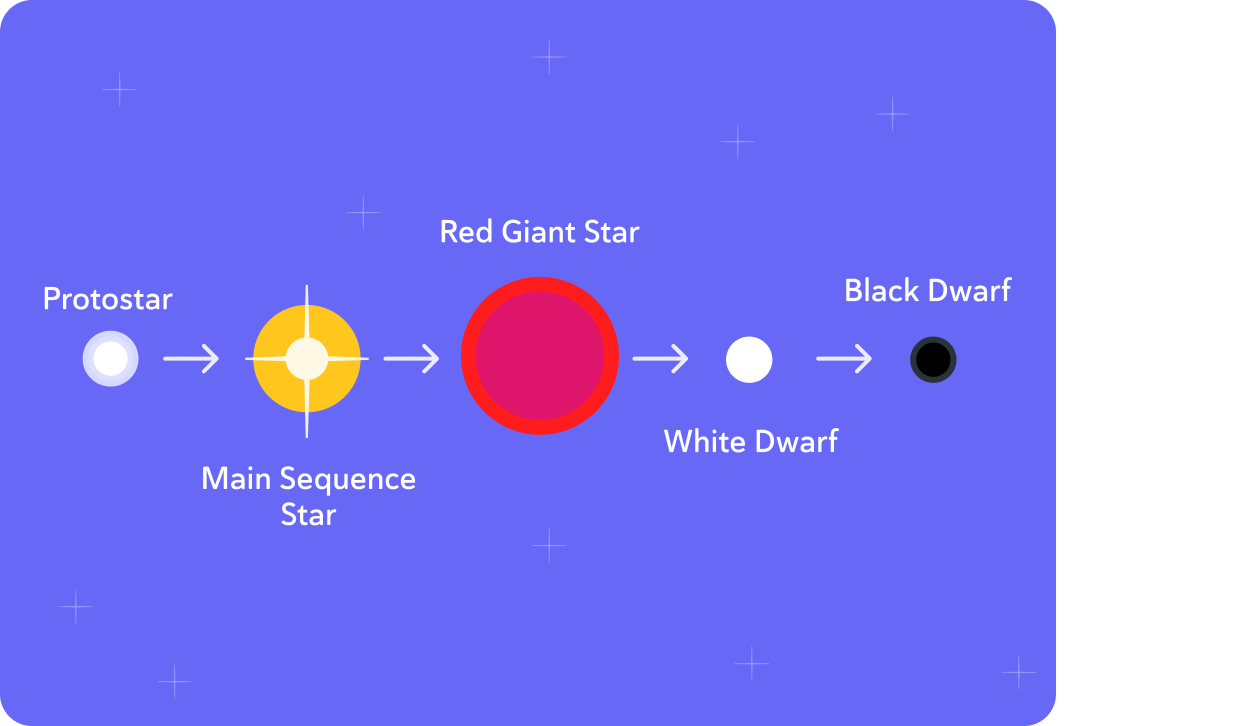YOU ARE LEARNING:
Star Life Cycles and the Size of the Sun

Star Life Cycles and the Size of the Sun
All stars begins as a cloud of dust, but depending on their size, gravity will dictate their outcome. Here we will see the history and future of our Sun.
All stars are formed from massive clouds of dust and gas, also known as nebulae. Nebulae are mostly composed of the lightest element in the periodic table. Which gas is that?

All stars are formed from a cloud of dust and gas that we call nebula. Stars with different masses grow and change in different ways throughout stages of their lives. This lesson will focus on stars that have similar mass to our Sun.
To begin with, the dust and gas of a nebula is very spread out. Over time, the particles come together and the nebula becomes more and more dense. What do you think is the force that pulls the nebula together?

How is a star born?
So far we know that gravity pulls together the dust and gas of a nebula.
This means that the nebula becomes denser.
As the nebula gets more concentrated it gets extremely hot! When it gets hot enough, hydrogen nuclei fuse together to make helium. This process produces energy. What is this process called?

A star is born when it is hot enough for nuclear fusion to occur - at least 150,000,000 ºC !
A star in this initial stage is called a protostar.
Nuclear fusion continues, releasing lots of energy in the process. What do you think that does to the core of the protostar?

The core of a protostar continues to get hotter and brighter as hydrogen is fused, creating helium.
The fusion process also creates pressure which expands the star.
So the first stage of a star is the protostar, but a star actually spends most of its life in the stage after that...
as a main sequence star. The diagram shows the forces acting on a main sequence star. Our Sun is currently in its main sequence stage. We expect that it will stay in this stage for billions of years.

In this stage the forces within it are balanced, so we say it is in...
A) imbalance. B) resultant. C) equilibrium.
Answer A, B or C.


Which force do you think is pulling the star inwards? Answer either "pressure from fusion" or "gravity".


While gravity pulls the star inwards, the pressure from the nuclear fusion has the opposite effect and pushes outwards.
This balance of forces keeps the star stable.

Our Sun (a main sequence star) is expected to run out of hydrogen in around 5 billion years. Will that have an impact on the star?

When a main sequence star runs out of hydrogen, the force of gravity becomes larger than the pressure from the fusion. This then causes the star to fuse helium, forming heavier elements. This new fusion process releases even more energy, so the star will...

When all of the hydrogen has been used up, the sudden increase in gravity causes the star to begin helium fusion. This creates heavier elements and even more energy is released. This increases the outwards pressure and the star will expand, giving off a red light. We call stars in this stage red giants.
The image shows the life cycle of a star with similar mass to our Sun.
After the red giant stage, a star becomes a white dwarf.

A star becomes a white dwarf when it runs out of fuel for nuclear fusion, so that there is no fusion force pushing the star outwards anymore. This explains its decrease in size because the star...
A) collapses under the force of gravity. B) expands because of the decrease of fusion force. C) collapses because there is less heat at its core.
Answer A, B or C.


The white dwarf star loses its outer layers, leaving just the hot and dense core which glows white. Without fusion, will happen to the temperature of the white dwarf over time?

To summarise, a star is born from a nebula into a protostar, and spends most of its life as a main sequence star. When it runs out of hydrogen it expands and becomes a red giant. Eventually, it will collapse into a white dwarf when all of its fuel for fusion has been used up.
If a white dwarf is a hot dense star which glows white, then how might it become a black dwarf?

If it takes more than one hundred million billion years for a white dwarf to become a black dwarf. Why have we never observed a black dwarf?

